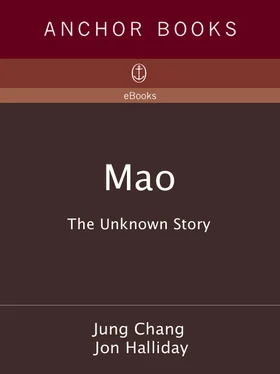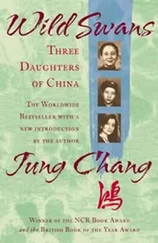Altogether, tens of thousands died in Jiangxi. In the army alone, there were about 10,000 deaths — about a quarter of the entire Red Army under Mao at the time — as revealed by the secret report immediately afterwards. It was the first large-scale purge in the Party, and took place well before Stalin’s Great Purge. This critical episode — in many ways the formative moment of Maoism — is still covered up to this day. Mao’s personal responsibility and motives, and his extreme brutality, remain a taboo.
Next door in Fujian, the local Reds had also rebelled against Mao, voting out his followers in July 1930 while he and his army were away. Many thousands were now executed; the figure, just taking those whose names are known and who were later officially cleared, is 6,352. In one county the victims were hauled through the streets to their execution with rusty wires through their testicles. Frightened and thoroughly disillusioned, the head of Red Fujian fled at the first opportunity, when he was sent to Hong Kong to buy medicine. He was only one of many senior Communists who deserted. Another was Peng De-huai’s de facto adopted son.
JUST AFTER THE mutiny against Mao, the Jiangxi Communists had appealed for support to Zhu De and Peng. “Comrades,” they pleaded, “is our Party going to be for ever so black and lightless?” These two had no love for Mao. One night after a good deal of rice wine, Zhu remarked to an old friend: “Many old comrades … have been killed in the purge. The man behind their killing is you know who.” The friend knew he meant Mao and said so in his memoirs. Then he quoted Zhu saying: “The Futian incident was also entirely caused by old Mao slaughtering AB. So many comrades have been killed …” Zhu “looked immensely sad.” However, he and Peng stuck with Mao. Shanghai and Moscow were behind Mao, and siding with the Jiangxi Reds would mean cutting themselves off from the Party. Mao had laid the groundwork for framing Zhu and Peng. He had been purging Zhu De’s staff, and had had two of Zhu’s five aides-de-camp executed. Nor would it be difficult for Mao to coerce some torture victim to make accusations against Zhu — and Peng. One message had reached Russia’s military intelligence chief in China suggesting that “Peng might be mixed up” in AB.
Not only did Mao blackmail the military commanders, he made sure they had the blood of their comrades on their hands. He ordered Zhu to sit on the panel that sentenced Liou Di to death.
Zhu and Peng did not stand up to Mao for another reason. At this time, in December 1930, Chiang Kai-shek had just won the war against his Nationalist rivals, and was launching an “annihilation expedition” against the Communists. Zhu and Peng cared about the Red Army, and feared that a split would doom it. Their attitude differed from Mao’s. During this and subsequent attacks by Chiang in 1931, Mao never halted the purge, and when the Generalissimo paused, Mao redoubled his internecine killings — even though the people he was killing had just been fighting Chiang at the front.
MAO’S RUTHLESSNESS PRODUCED an effective policy against Chiang. This was to “lure the enemy deep into the Red area and strike when it is exhausted.” Mao argued that as the Nationalists were not familiar with the terrain, the conditions must favor the Reds. Because there were so few roads, Nationalist troops would have to rely on local supplies, and since the Reds could control the population they could deprive the enemy of food and water. Mao’s plan was to force the entire population to bury their food and household goods, block every well with huge stones, and evacuate to the mountains so that Chiang’s army could not find water or food, or laborers and guides. The strategy turned the Reds’ base into a battlefield, imposing colossal hardships on the entire population, whom Mao forced into harm’s way.
Few Red leaders agreed with Mao, but his strategy worked. A Nationalist commander later lamented that everywhere “we saw no people, the houses were cleaned out as if by floods, there was no food, no woks, no pots … We couldn’t get any military information.” Chiang reflected in his diary: “The difficulty of annihilating the [Communist] bandits is greater than a big war, because they fight in their territory and can get the population to do what they want.”
Yet it was not Mao’s brutal strategy that clinched the Reds’ victory. What really tipped the scale was Russian assistance — though this remains virtually unknown. Moscow set up a top-level Military Advisory Group in the Soviet Union to plan strategy, and a military committee in Shanghai, staffed by Russian and other (especially German) advisers. The critical help came from Soviet military intelligence, the GRU, which had a network of more than 100 agents in China, mostly Chinese operating in Nationalist offices near the Red Army, whose main job was to provide information to the Chinese Communists. In early 1930, Moscow had dispatched a star officer, the half-German, half-Russian Richard Sorge, to Shanghai. Sorge’s main coup was to infiltrate the German military advisers’ group at Chiang’s forward intelligence HQ, where he worked on the disgruntled wife of one of the advisers, Stölzner, to steal the Nationalist codes, including those used for communications between the General Staff and units in the field. This information from Russian spies gave Mao an incalculable advantage. The CCP also had its own agents working in the heart of Nationalist intelligence. One, Qian Zhuang-fei, became the confidential secretary of the Nationalist intelligence chief U. T. Hsu, and played a big role in Mao’s success.
These intelligence networks provided Mao with precise information about the movements of Chiang’s army. Two weeks into the expedition, on 30 December 1930, Mao used 40,000 troops and civilians to lay an ambush against 9,000 Nationalist troops. The previous day he had learned exactly which units were coming, and when. Mao waited from dawn on a distant peak, while fog and mist shrouded the mountains, and then watched the action amidst maple leaves, some still blazing red on the trees and others fallen on the frosty ground. In the afternoon sunshine, excited cries from below announced victory. Most of the Nationalist troops had simply put up their hands, and the Nationalist commander was captured. The general was exhibited at a mass rally, which Mao addressed, and at which, under guidance, the crowd yelled: “Chop his head off! Eat his flesh!” His head was then sliced off, and sent down the river attached to a door, with a little white flag saying it was “a gift” for his superiors.
This ambush ended Chiang’s first expedition, from which the Red Army gained both arms and prisoners, as well as radios and radio operators. Mao’s prestige rose. Few had any idea about the critical role played by Russian intelligence, as well as by Russian money, medicine and arms. Mao had even asked for poison gas.
In April 1931, Nationalist troops came back for a second “annihilation expedition.” Again they were thwarted by the tactic of “luring the enemy deep into the Red area,” and again Moscow provided critical aid and intelligence, this time including a high-powered two-way radio acquired from Hong Kong, and Russian-trained radio technicians. For this campaign, Mao was able to intercept enemy communications.
But at the beginning of July Chiang Kai-shek himself led a vastly expanded force of 300,000 men for a third expedition, and modified his tactics so that it was much harder for Mao to use his intelligence advantage to lay ambushes. Moreover, this time the Generalissimo’s forces were ten times the size of Mao’s, and were able to stay and occupy the areas they were “lured” into. The Red Army found itself unable to return. Within two months the Red base had been reduced to a mere several dozen square kilometers, and Mao’s men were on the verge of collapse.
Читать дальше










